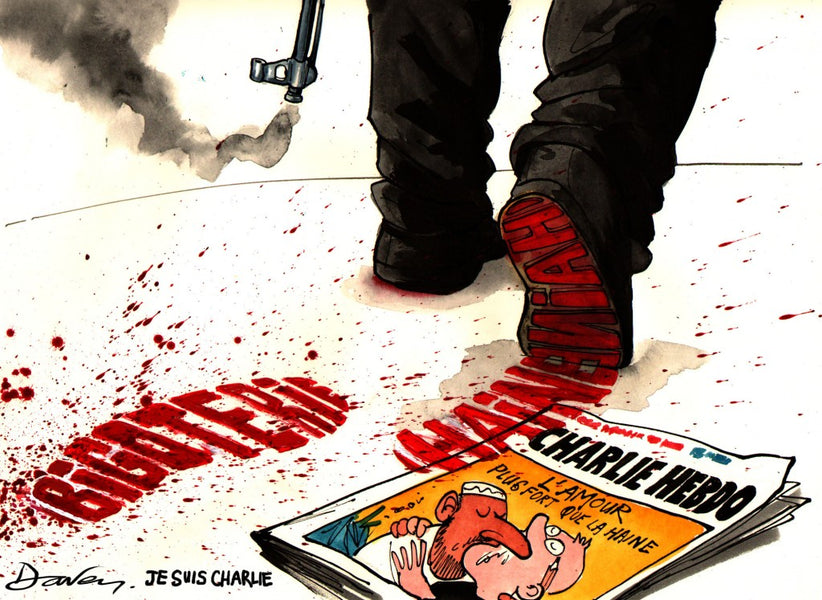One year on from the Charlie Hebdo shootings, on the day when an anniversary edition of Charlie Hebdo appears on the newsstands with a cover depicting a “God” bearing bloody hands and a rifle, I feel like reflecting on what it all meant. I’m not sure the thoughts will be very coherent but here goes. I am a cartoonist, so the events of last January in Paris have a strong resonance for me, not least because I don’t want to be killed by terrorists.
I guess I’m happy to say “Je suis Charlie” but I should probably also say rather weedily that “je ne suis pas un agent provocateur”. Charlie Hebdo cartoonists were and are brave for taking the strong position they have taken for many years on the hypocrisies of organised religion. I wouldn’t choose to deliberately provoke, like Charlie Hebdo does, but there is nothing wrong to my mind with the image as depicted on the cover of the current magazine. Drawn images are powerful things. This is a metaphor. The non-denominational God is presumably meant to represent religion generally. The point I take is that religious disharmony is still causing death. To depict a non-denominational God as a metaphor for bloody violence seems a pretty reasonable position to take since huge numbers of people have been slaughtered by angry men in his name over many centuries. However, many people will angrily assume it confirms their prejudices and say that “Charlie Hebdo is saying God carries a gun. How sacrilegious!” It is a picture. Not a bomb. It would be useful if everyone looked at it, thought about it and moved on.
It would be nice to be able to draw what I want. However, I know that I have no absolute right to such freedoms. Rights are conferred by a society and often won through generations of struggle. And along with rights come responsibilities. In this case, that responsibility is to consider the readers’ genuine sensibilities. The point of political cartoons is, to borrow Finlay Peter Dunne’s journalistic adage , to “afflict the comfortable and comfort the afflicted”. Or, put differently, to show up hypocrisy and abuses of power by the powerful so as to provide some comfort, levity or perhaps an alternative viewpoint for those not in power.
I don’t want to insult ordinary people for their personal beliefs, spiritual or secular. I have no brief to ridicule Christians, Muslims, Jews, Zoroastrians or atheists because of how they see the universe, as long as they profess tolerance and peace. But I would like to be able to point out the hypocrisies of organised religions and their entrenched hierarchies, especially if the power-brokers of those sects act irresponsibly or foster disharmony. In an Islamic context, I have no wish to mock The Prophet Mohammed but I do want to show up the evil perpetrated by certain misguided people calling themselves Muslims, in positions of power. And guns give you power, albeit local. I would also like to be able to softly point out the humour in belief itself. I see this as simply holding a mirror to ourselves as human beings. Most human activities reveal comical aspects when held up to close scrutiny.
The problem of aniconism (banning the creation of images of gods and prophets as false idols) is real. Largely, since the Reformation, with a few wobbles, Christian society has accommodated it to the point where it is no longer a source of conflict. However, that is not the case in Islam where the ban extends widely – but variably – to the creation of images of any sentient living beings, with notable local exceptions. To the modern western mind, this sounds absurd in its wider form and questionable even in its restricted form.
We live in western democracies. We should be able to speak freely and draw pictures freely. If it offends you, well, don’t look at it. Or turn the other cheek. It’s easy to be offended by all sorts of things in our world but it doesn’t mean that you have to kill someone for it. Killing people for drawing pictures is not part of any religious experience. It is simply the projection of someone’s anger through a prism of their warped belief on to a person armed with only a pen. The Pope is quoted in the Vatican daily, saying “If a good friend speaks badly of my mother, he can expect to get punched, and that’s normal. You cannot provoke, you cannot insult other people’s faith, you cannot mock it.” This is a hot-blooded angry man speaking, rather than a tolerant religious leader. It doesn’t help.
Although they are rarely carried out, death threats are no new thing for political cartoonists. They come from various aggrieved sources. The thread that binds these people is not religion, but that they are, well, nutters. Anybody who seeks to kill another person because he (it is almost always “he”) dislikes something the other has written, spoken or drawn is a psychopath, regardless of whether it is dressed up as religion or not. These killers in Paris committed acts of evil, not redemption. The fact that terrorists are almost always male is crucial. The attraction of sophisticated weaponry to young men, whether it be real or virtual in computer games, is a commonplace. When these men are disaffected and dissatisfied with their lot to the point of social exclusion, and have access to weapons through criminal gangs or politico-religious zealots, the possibility of horrendous bloody crime increases.
And the killing of the cartoonists should be put into context. In the same week as the Charlie Hebdo shootings, apparently up to 2000 people were murdered by self-proclaimed “Islamist” zealots in Baga, northern Nigeria. This was only briefly reported in the media. Many of the victims were Muslims. But more importantly, they were innocent people.




